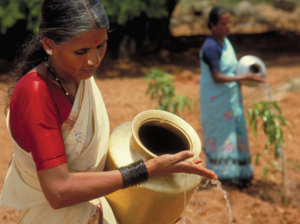InnoWat: IFAD & rural water investments
 IFAD is currently engaged in over 230 loan operations in 85 countries. About two thirds of that portfolio is related to community-based natural resource management. Poor rural people and their institutions are at the core of this approach. Water is critical to these men and women pastoralists, fishers, farmers, young and old, part- or full-time, urban or rural, indigenous, tribal or otherwise often marginalized people. Itis the key entry point for improving their livelihoods. Water-related interventions are often linked to the building up or restoring of the asset base – and involve many facets and uses. This holistic view is part of the characterization of IFAD’s approach to water interventions in this fact sheet: rather than considering water solely as an input factor in the production chain, we have preferred to follow water throughout rural people’s livelihoods. This approach, combined with a qualitative analysis of the ongoing 2007/08 loan portfolio, yielded a few surprising insights (table 1).Almost half of all projects (45-50 per cent) involve aspects of water resource management at catchment or watershed levels, and hence beyond the immediate household or community level of use.
IFAD is currently engaged in over 230 loan operations in 85 countries. About two thirds of that portfolio is related to community-based natural resource management. Poor rural people and their institutions are at the core of this approach. Water is critical to these men and women pastoralists, fishers, farmers, young and old, part- or full-time, urban or rural, indigenous, tribal or otherwise often marginalized people. Itis the key entry point for improving their livelihoods. Water-related interventions are often linked to the building up or restoring of the asset base – and involve many facets and uses. This holistic view is part of the characterization of IFAD’s approach to water interventions in this fact sheet: rather than considering water solely as an input factor in the production chain, we have preferred to follow water throughout rural people’s livelihoods. This approach, combined with a qualitative analysis of the ongoing 2007/08 loan portfolio, yielded a few surprising insights (table 1).Almost half of all projects (45-50 per cent) involve aspects of water resource management at catchment or watershed levels, and hence beyond the immediate household or community level of use.
InnoWat: IFAD & rural water investments
Authors: Cohen, A. & Nepveu de Villemarceau, A.
Publication Year: 2009 | Journal / Publisher: Rome: United Nations International Fund for Agricultural Development
 IFAD is currently engaged in over 230 loan operations in 85 countries. About two thirds of that portfolio is related to community-based natural resource management. Poor rural people and their institutions are at the core of this approach. Water is critical to these men and women pastoralists, fishers, farmers, young and old, part- or full-time, urban or rural, indigenous, tribal or otherwise often marginalized people. Itis the key entry point for improving their livelihoods. Water-related interventions are often linked to the building up or restoring of the asset base – and involve many facets and uses. This holistic view is part of the characterization of IFAD’s approach to water interventions in this fact sheet: rather than considering water solely as an input factor in the production chain, we have preferred to follow water throughout rural people’s livelihoods. This approach, combined with a qualitative analysis of the ongoing 2007/08 loan portfolio, yielded a few surprising insights (table 1).Almost half of all projects (45-50 per cent) involve aspects of water resource management at catchment or watershed levels, and hence beyond the immediate household or community level of use.
IFAD is currently engaged in over 230 loan operations in 85 countries. About two thirds of that portfolio is related to community-based natural resource management. Poor rural people and their institutions are at the core of this approach. Water is critical to these men and women pastoralists, fishers, farmers, young and old, part- or full-time, urban or rural, indigenous, tribal or otherwise often marginalized people. Itis the key entry point for improving their livelihoods. Water-related interventions are often linked to the building up or restoring of the asset base – and involve many facets and uses. This holistic view is part of the characterization of IFAD’s approach to water interventions in this fact sheet: rather than considering water solely as an input factor in the production chain, we have preferred to follow water throughout rural people’s livelihoods. This approach, combined with a qualitative analysis of the ongoing 2007/08 loan portfolio, yielded a few surprising insights (table 1).Almost half of all projects (45-50 per cent) involve aspects of water resource management at catchment or watershed levels, and hence beyond the immediate household or community level of use.
PDF on Publisher Website | PDF on OSF
